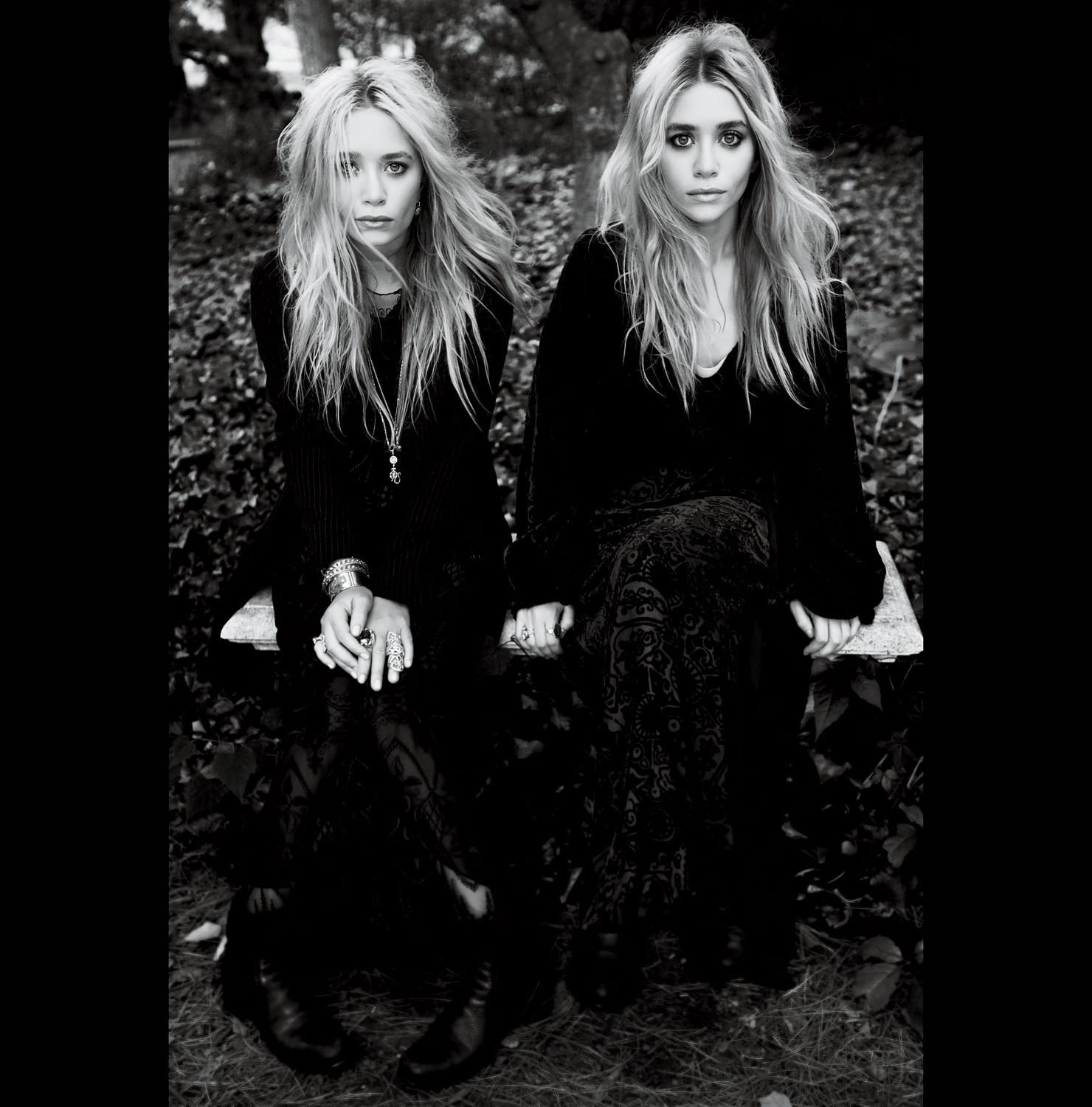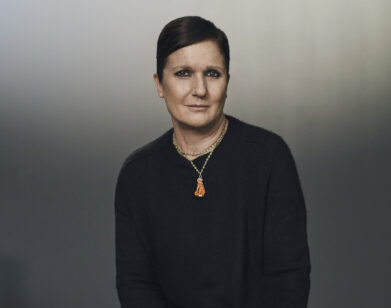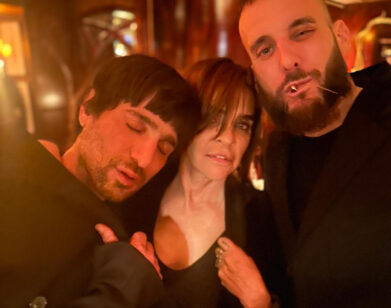The Row
When we first started, we wanted to have a front man because we just knew how hard it was going to be.Mary-Kate Olsen
Joseph Altuzarra, Prabal Gurung, and Mary-Kate and Ashley Olsen for The Row: Those were the 2011 nominees for the Swarovski Award for Womenswear, the CFDA’s honor for emerging talent in ready-to-wear design. Altuzarra honed his skills at Givenchy, Gurung at Bill Blass, and the Olsens at . . . Wal-Mart. But while the “Save Money, Live Better” monolith of mass consumerism might not be the most obvious training ground for the higher ranks of American luxury, the Olsens are not to be underestimated. By the time they were 18, the former child stars had successfully parlayed their shared role as Michelle Tanner on the late ’80s TV comedy Full House and twin performances in a series of direct-to-video films for tweens into a $1 billion-a-year business called Dualstar that merchandised dolls, makeup, accessories, and, of course, clothing. In fact, the Olsens—who had been wearing samples from the likes of Marc Jacobs and Chanel, cut down to children’s size, from the age of 6—have always had an uncanny ability for translating runway fashion for their avid young following.
However, Mary-Kate and Ashley entered a new fashion sphere in 2004 when they retired from their screen sister act, and relocated from California to Manhattan to attend New York University. Snapped daily in their freshly minted uniform of leggings, grandpa sweaters, and face-obscuring Dior bug-eye sunglasses, they became the emblem of “hobo-chic,” the ubiquitous look of East Coast coeds. (In their freshman year, the twins also assumed ownership of Dualstar; their wealth has been estimated at $137 million each.)
It was from beneath this layered-to-the-max carapace that the Olsens embarked on a project that would be their gateway into full-fledged fashion design: creating the “perfect” T-shirt. That was the germ of their elevated basics line The Row. From these (relatively) humble origins, growth was slow but steady. The label made its runway debut at New York Fashion Week just three seasons ago with a tightly edited 19-look collection of black silk crepe de chine straight-cut tops and straight-leg trousers that turned out to be one of the most critically well-received shows for Fall 2010, a season that heralded a return to classic American sportswear. Since then, the materials have grown more opulent. For Fall 2011, a fur-tuft T-shirt made of cashmere and fox rubs up against the glossy crocodile backpacks and box-frame ostrich cross-bodies that comprise The Row’s first in-house accessories collection.
Anne Slowey caught up with Mary-Kate and Ashley, now 25, in their Chelsea studio.
ANNE SLOWEY: You’re talking to someone who just barely bought a TV, so, you know, I only know you as fashion people. Does the level of credibility you’ve established within the industry surprise you?
ASHLEY OLSEN: I think my sister and I just focus on working hard. We started off working with Wal-Mart on our first clothing line as an extension of our personal brand when we were 12, and we got to learn about being aware of what was in the market and what wasn’t. When we were 18, we decided to take a step back and go to school. But after a year at NYU, I think we were kind of bored because we were used to constantly juggling both worlds!
SLOWEY: The Row began with the search for the perfect T-shirt, right?
MARY-KATE OLSEN: It was a project for a great T-shirt that we thought maybe we would do for The ONE Campaign [the global organization fighting extreme poverty and preventable disease, particularly in Africa].
ASHLEY: We didn’t end up doing that, but we loved the fabric and got the best fit that we could create.
MARY-KATE: It all started with us talking with our friends about the T-shirt—just putting it on bodies, on anyone from 12 to 60, and different sizes.
ASHLEY: We wanted it to be different sizes; we wanted it to be timeless. So it was learning about production and manufacturing, one piece at a time.
SLOWEY: What came next after the T-shirt? When did you realize that you were creating a collection?
ASHLEY: It was a T-shirt, and then a tank top, and then a dress—
MARY-KATE: And then a blazer, and then the stretch-leather leggings—which I think people thought was a crazy idea at first.
SLOWEY: But then everybody wanted them! I know Lauren Hutton’s a fan.
ASHLEY: I think our first-ever magazine cover was of her on Forbes on a motorcycle in the leggings. SLOWEY: You couldn’t ask for a better fit model than Lauren Hutton. She’s the epitome of a smart, understated, take-no-prisoners woman.
ASHLEY: I think The Row skews toward an older market—an educated consumer who’s been shopping for years. The main thing we thought was lacking in the luxury market were basic pieces that could break up an outfit so you didn’t feel like you were totally dressed in one designer. You could add some ease and comfort, tone it down.
SLOWEY: When you start working on a collection, are you thinking about specific pieces that are missing from most wardrobes?
ASHLEY: Our core business are those pieces that you really want to have accessible to you but you don’t really want to worry about, like a great white button-down.
MARY-KATE: But now we have daywear, nightwear, the item that goes anytime, too.
SLOWEY: At what point did you realize that you were successful and being taken seriously as designers?
ASHLEY: I don’t think we ever did.
MARY-KATE: We still don’t. We just go from season to season, hoping that people enjoy what we make.
SLOWEY: You’re not being looked at as celebrities designing but as designers who are designing things women want.
ASHLEY: Well now it’s funny because most designers have become celebrity-type figures. I hate that word, celebrity, but it’s not necessarily the brand that’s being branded, it’s they themselves.
SLOWEY: You guys have worked the reverse magic.
MARY-KATE: It’s a non-branded brand.
SLOWEY: I’m noticing a very tasteful logo here. I think it would be good to talk just a little bit about how you came up with your hardware and made those kinds of decisions.
MARY-KATE: We didn’t like tags. We didn’t like labels. We wanted something very chic, very minimal. So we always go back to metals as our hardware for branding.
ASHLEY: We didn’t want a lot of hardware at all. We just let metal be our label. Our first season we just did gold, and then we introduced silver for resort.
SLOWEY: It’s very discreet. Who’s your favorite designer? Other than yourselves . . .
ASHLEY: We like Yohji Yamamoto and Karl Lagerfeld, and Dries Van Noten, the way he uses color. Then old Coco Chanel as well.
MARY-KATE: I remember the first time we walked into Prada—was it in Rome?
ASHLEY: No. I think before.
MARY-KATE: Well, I remember going in, and then traveling. We had to drive from Milan to—from Florence to Milan? Or from Florence to Rome?
ASHLEY: It was the outlet—the Prada/Miu Miu/Jil Sander outlet—outside of Florence. I was going nuts there because everything’s like $40 and the dollar was so strong at that point.
SLOWEY: Right, that’s when Italy was still a Third World country and everything was lire. So 3,000 lire was $40.
ASHLEY: Our dollar was so strong. And all the nylon bags . . .
SLOWEY: I think we were all on shopping heydays in the mid-’90s. So what do you think it is that women are looking for now when they go out in search of personal style? Because you’ve obviously always been looked up to as style icons.
ASHLEY: I think women just want to feel comfortable—
MARY-KATE: And chic—
ASHLEY: And understated.
SLOWEY: Do you feel your style has changed as you’ve become designers? I think there’s an imprint in everybody’s mind of, you know, the grunge inspiration from your NYU days.
MARY-KATE: People were really fascinated by it, but I just think it was laziness on our part! We came to New York from California, and we didn’t know what to wear in the snow. So it’s like, whatever I could find I just put on.
SLOWEY: There’s this great quote where you’re just like, “I was cold! I put a sweater on!”
MARY-KATE: It was freezing. My nose turned bright red!
SLOWEY: Were a lot of people following you around?
ASHLEY: Yeah, the magazines. They hired 10 guys to be on the field.
SLOWEY: And does there ever come a point in time where you just aren’t aware of it anymore?
ASHLEY: I’m constantly, painstakingly aware of it. I think we’ve also grown some tough skin. We don’t read anything.
SLOWEY: No, you can’t. Except you would read your reviews, I’d imagine.
MARY-KATE AND ASHLEY: No!
SLOWEY: Well, they’re good. [all laugh] But that’s probably smart, just to tune it out and to stay focused and do what you do and not second guess. Would you say that a motivator for moving to New York was trying to craft together some semblance of normalcy?
ASHLEY: No. I think we just knew that that was just where we wanted to educate ourselves.
SLOWEY: And it’s also the place to run a fashion business.
ASHLEY: It turns out! We actually started in L.A. I used to fly to school—I did classes Tuesday, Wednesday, Thursday so I could leave Thursday night or Friday and be in the factory with people Friday, Saturday, Sunday. So we traveled back and forth, but once we started to do jackets and the tailored bits, we started to work here.
MARY-KATE: When we first started, we wanted to have, like, a front man because we just knew how hard it was going to be. We wanted to have someone else be claiming to design it.
SLOWEY: And at what point did you realize that wasn’t going to work?
ASHLEY: Like within the first . . . [laughs] “You have to take this to Vogue.”
SLOWEY: Well, it is such an extension of your own personal style now, that really to have someone else represent it probably wouldn’t have worked. But at what point did you realize you were dressing in a way that people were obsessed with and mimicking you?
ASHLEY: Honestly, we started the Wal-Mart line because of that exact thing. It came from our fan base saying, “We’re mothers; where can I get these clothes for my kids?” And the truth was we were cutting down adult clothes to fit a kids’ size 6X.
SLOWEY: So you’d say your fashion-school education was your real-life experience?
MARY-KATE: We’d have to do at least 20 looks—
ASHLEY: In four days. We’d walk in the room with racks and racks of clothes. So it was just all about editing.
SLOWEY: Your new collection of bags for The Row is amazing. The color palette is sophisticated and they’re done at such an exquisite level.
MARY-KATE: We didn’t want it to be trend based. We wanted something that had longevity.
SLOWEY: It’s so not about the It bag anymore. And how did you figure out shapes?
ASHLEY: They’re light, but we really wanted well-constructed pieces. I think that for so long everything was so unconstructed.
SLOWEY: Yeah, those giant slouchy bags that were bigger than your head.
MARY-KATE: I feel like when I carry a bigger bag it looks like it’s a huge bag because I’m really tiny. But I do think it’s important to have the space that you need, because we throw everything in our bags at all times. I think every woman does. This was the first sample that we did. Now, look at all the stuff I have in it!
SLOWEY: But it still looks pulled-together. That doesn’t look like a crazy person’s bag. I mean some of these bags got to the point where it looked like you were shoving the entire contents of your closet in there. But I do think offering these kinds of tailored bags requires—at least for me, I would have to go through extreme personality overhaul to decide what’s not going in the bag.
ASHLEY: I know.
SLOWEY: You always want to look like the woman who’s only carrying cigarettes and a phone.
ASHLEY: That’s the thing.
SLOWEY: Maybe not the cigarettes, but you have them. The lipstick, the key, the credit card.
ASHLEY: One of the first designs was the backpack. We always wanted to do a backpack because it’s very New York. But the rest came from men’s suitcases and briefcases, trying to make a feminine version.
SLOWEY: You also collaborated with TOMS Shoes this season?
MARY-KATE: We sold 13,000 pairs of the TOMS + The Row cashmere slip-ons—I think they’re all sold out now. And we actually just came back from a shoe drop [the Honduras Shoe Drop with TOMS, The Row, and World Vision] in Honduras with [TOMS founder] Blake Mycoskie.
SLOWEY: You guys actually went and you handed out shoes? How many shoes did you drop?
MARY-KATE: We probably did at least 50 each per drop, but we were also with another 10 or 12 people also doing it.
ASHLEY: We did three different drops in different areas, and the kids would all line up, and we were just, like, cleaning off their feet.
SLOWEY: [looking at a photo of a young TOMS recipient] Wow, she’s so beautiful.
MARY-KATE: I know. Her whole dress was made out of, like, moss and beans.
ASHLEY: She was the princess of the year.
MARY-KATE: It was really emotional when we got back and everything set in.
ASHLEY: We’re already planning our next trip.
SLOWEY: What’s your inspiration for your spring collection for The Row?
ASHLEY: We’ve kind of started with Nick Cave and a bunch of different sounds.
MARY-KATE: What you’ll see is that there’s not one piece of black. The whole collection’s pretty much white or a shade of white.
SLOWEY: Who would you say are your biggest fans?
ASHLEY: A lot of men love it, actually. I think we almost get more compliments from men about the clothes than from women.
SLOWEY: Seriously? Interesting. What do they say?
ASHLEY: They just like how it feels when . . .
SLOWEY: When they’re molesting their dates?
MARY-KATE: Yeah, exactly. [all laugh]
ASHLEY: But I think all guys have this perception of wanting women to be in jeans and a T-shirt looking naturally beautiful. That’s kind of where we come from. A lot of these are just basic clothes, nothing crazy or ridiculous.
SLOWEY: Well, they’re easy, they’re relaxed, and ultimately, they’re sexy, in a way that men can relate to, so you’ve done it.
ASHLEY: And there’s so much more to do!
Anne Slowey is the Fashion News Director at Elle Magazine.







